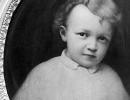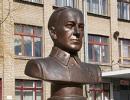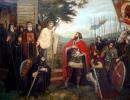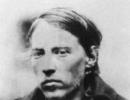Trafalgar Square. Trafalgar Square. Trafalgar Square Trafalgar Square description in English
Trafalgar Square, set in central London, is one of Britain's great tourist attractions. A visit to the capital would be incomplete without going to marvel at Nelsons Column and the four giant lions at its base, or to admire the lovely splashing fountains and to feed the pigeons, who have made their home here.
It was John Nash, who designed the first layout of the square in the 1820's. Although he didn't live to see its completion, his Neo-classical design was adhered to, achieving the unified effect of the beautiful buildings we admire today . Building of the square began in 1829 and was still being developed into the 1840's.
The National Gallery occupies the north side of the square. In the stone under the balustrade, you can see the Imperial Standards of Length (1 foot, 2 feet, 1 yard etc.).
On the east side is South Africa House, with African animals featured on the stone arches. Sir Robert Smirke, who designed The British Museum, also created Canada House, on the west side. Now open to the public, Canada House is worth a visit to enjoy the original classical interior, and to see the interesting changing exhibitions on view. Visiting Canadians may be interested to know that they can read the Canadian newspapers, browse on line, or send and receive emails in Canada House.
The chartists assembled in Trafalgar Square in 1848 and since then, it has been a favorite meeting place for demonstrators and marchers, trying to gain attention for their cause.
Each year in December, the people of Norway send a gift of an enormous Christmas Tree to Britain, which is erected in Trafalgar Square. This is in thanks for Britain"s part in their liberation during the second world war. One of the unforgettable sights of London is to see the giant tree after dark, when it is lit by hundreds of twinkling fairy lights, carol singers grouped around, while floodlights illuminate the sparkling water in the fountains of the square.
The equestrian statue of Charles I at the south end of the square is noteworthy, as being the original site of Charing Cross. This is the spot from which all "distances from London" are measured. Edward I erected a cross here in 1290, the last of twelve marking the resting places of the funeral cortege of his wife Eleanor as it made its way from Nottinghamshire to Westminster Abbey. The cross remained on this spot, until its removal during the civil war in the mid 17th century. A replica was placed in the forecourt to Charing Cross Station two centuries later.
Surrounding Nelson are statues of other distinguished men. On either side, are the bronze statues of Sir Henry Havelock and Sir Charles James Napier both Victorian major generals. Fronting the north wall are busts of Beatty, Jellicoe and Cunningham all famous military leaders. In the north east corner, is a statue of George IV on horseback, commissioned by him, while in the opposite corner the pedestal does not yet have a permanent statue.
REPORT
in English language
On the topic: “Trafalgar Square. Trafalgar Square"
Prepared by: Gryaznov Sasha
5th grade
2018
Trafalgar Square
This is one of the centers of London. The square was named Trafalgar Square to commemorate the historic naval victory of the English fleet under the command of Horatio Nelson over the mixed Franco-Spanish fleet under the command of Villeneuve on October 21, 1805. The battle took place at Cape Trafalgar at the mouth of the Strait of Gibraltar and lasted several hours. Nelson was mortally wounded by a gunshot that shattered his spine. He died aboard his flagship, the Victoria, but not before being told that he had won the fight.
Nelson's Column, topped with a statue of Admiral Lord Nelson, dominates the center of Trafalgar Square. This is the most impressive monument, it is 170 feet (about 52 meters) high. The statue of Nelson, facing the sea, which he loved so much, and its height is about 17 feet (more than 5 m).
To the northeast of Trafalgar Square is the building that houses the National Gallery of Art, one of the most important art galleries in the world, and behind the National Portrait Gallery.
Very often the square becomes a meeting place, and crowds of Londoners gather here in case of political debates. Thus, we can say that Trafalgar Square is the heart, the beating of which is transmitted to all Londoners.
There are many pigeons in the square, and the people of London love to feed them. Everyone knows that the dove is a symbol of world peace.
Trafalgar Square
This is one of the nerve centers of London. It was named Trafalgar Square to commemorate the historical naval victory won on the 21st of October 1805 by the British fleet under the command of Horatio Nelson over the combined French-Spanish fleet commanded by Villeneuve. The battle took place at Cape Trafalgar in the mouth of the Straits of Gibraltar and lasted several hours. Nelson was fatally wounded by a shot which broke his backbone. He died on board his flagship the Victory, but not before being told that he had won the battle.
Nelson's Column, with the statue of Admiral Lord Nelson on top, rises in the center of Trafalgar Square. This most impressive monument is 170 feet (about 52 m) tall. The statue of Nelson, placed facing towards the sea he loved, measures 17 feet (more than 5 m) in height.
To the north-east of Trafalgar Square there is the building that houses the National Gallery of Art - one of the most important Art Galleries in the world - and behind is the National Portrait Gallery.
Quite often the square becomes the location for meetings and in it crowds of Londoners congregate to celebrate political rallies. So it can be said that Trafalgar Square is the heart from which the beat is emitted to all the Londoners.
There are many pigeons in the square and Londoners like to feed them. Everybody knows that the dove is the symbol of peace all over the world.


This is one of the nerve centers of London. It was named Trafalgar Square to commemorate the historical naval victory won on the 21st of October 1805 by the British fleet under the command of Horatio Nelson over the combined French-Spanish fleet commanded by Villeneuve. The battle took place at Cape Trafalgar in the mouth of the Straits of Gibraltar and lasted several hours. Nelson was fatally wounded by a shot which broke his backbone. He died on board his flagship the Victory, but not before being told that he had won the battle.
Nelson's Column, with the statue of Admiral Lord Nelson on top, rises in the center of Trafalgar Square. This most impressive monument is 170 feet (about 52 m) tall. The statue of Nelson, placed facing towards the sea he loved, measures 17 feet (more than 5 m) in height.
To the north-east of Trafalgar Square there is the building that houses the National Gallery of Art - one of the most important Art Galleries in the world - and behind is the National Portrait Gallery.
Quite often the square becomes the location for meetings and in it crowds of Londoners congregate to celebrate political rallies. So it can be said that Trafalgar Square is the heart from which the beat is emitted to all the Londoners.
There are many pigeons in the square and Londoners like to feed them. Everybody knows that the dove is the symbol of peace all over the world.
Trafalgar Square
This is one of the centers of London. The square was named Trafalgar Square to commemorate the historic naval victory of the English fleet under the command of Horatio Nelson over the mixed Franco-Spanish fleet under the command of Villeneuve on October 21, 1805. The battle took place at Cape Trafalgar at the mouth of the Strait of Gibraltar and lasted several hours. Nelson was mortally wounded by a gunshot that shattered his spine. He died aboard his flagship, the Victoria, but not before being told that he had won the fight.
Nelson's Column, topped with a statue of Admiral Lord Nelson, dominates the center of Trafalgar Square. This is the most impressive monument, it is 170 feet (about 52 meters) high. The statue of Nelson, facing the sea, which he loved so much, and its height is about 17 feet (more than 5 m).
To the northeast of Trafalgar Square is the building that houses the National Gallery of Art, one of the most important art galleries in the world, and behind the National Portrait Gallery.
Very often the square becomes a meeting place, and crowds of Londoners gather here in case of political debates. Thus, we can say that Trafalgar Square is the heart, the beating of which is transmitted to all Londoners.
There are many pigeons in the square, and the people of London love to feed them. Everyone knows that the dove is a symbol of world peace.
Is Trafalgar Square. It's a place where the three Westminster's streets: Strand, Whitehall and Mall meet. It’s a traditional place for meetings, demonstrations, other gatherings and mass events holding. The main country's Christmas tree imported from Norway is set there annually. Norway presents Britain with a tree to thank for liberation from the Nazis.
It was named so by George Taylor in commemoration of the Battle of Trafalgar that took place in 1805. In the center of the square the Nelson’s Column, surrounded with fountains, is situated. Horatio Nelson was a commander admiral at that historical naval battle who died defeating Napoleon. His statue erected in 1843 is about 200 feet high and has 4 sculpted lions on its basement (added later on).


There are 4 plinths in every corner of Trafalgar Square with statues of George IV, Charles Napier, and Henry Havelock. The northwest plinth also known as the fourth plinth remained empty for 150 years. There should have been an equestrian statue of King William IV. Thought due to the lack of money the project wasn't completed. Recently it has been decided to place there modern art installations that should be changed every 2 years. Since 2013 there is an ultramarine blue statue of Hahn/Cock.

The National Gallery of London is also located on the north side of the square. It was completed in 1843. Its collection is compiled of the masterpieces of famous artists: Rafael, Rembrandt, Titian, Hogarth, Michelangelo, Rubens, Renoir and other. The National Portrait Gallery is a world-renowned gallery that has in its disposal the portraits of outstanding British people since Tudor times till nowadays. The portraits are arranged thematically and must depict people who have been dead at least for ten years.

And South Africa houses as well as Admiralty Arch and St. Martin-in-the-Fields' church are other prominent places of visit located nearby. The style of the last one had been copied by various architects for building churches, especially in the USA.
If a tourist experiences some troubles, he can ask for the help the heritage wardens which are present in the square around the clock. They provide with the appropriate answers and may give some pieces of advice as for the nearby attractions.
Till the recent time the doves were a special attraction of the place. There could be up to 35 thousand pigeons on the square simultaneously. Partially it was because of the tourists who fed birds. In fact, that made a great problem as the city administration spent 160 thousand dollars for cleaning the streets and monuments from the bird droppings every year. In 2007 the feeding pigeons was strictly prohibited that led to the decreasing of the birds number.
One of the main tourist centers of London and the whole of Great Britain is Trafalgar Square, the main square of London, where most of the official celebrations and holidays of the country are held.
It is here that on the eve of the New Year and Christmas holidays, the country's main city tree is set up.
History of Trafalgar Square
Trafalgar Square was not always the center of London; until the beginning of the 19th century, royal stables were located on this site. King Edward I decided to dismantle the stables and build a square on this site, initially the square bore his name.
The architect Charles Bury designed the square, its theme was dedicated to the victory of the English fleet in 1805 in the Battle of Cape Trafalgar.
Attractions in Trafalgar Square
Nelson's Column
In the very center of the square there is a monument to the legendary admiral - a column crowned with a five-meter figure of Horatio Nelson. The 44-meter column was installed in 1842, it was made by sculptor William Railton from dark gray granite.
A quarter of a century later, four six-meter lions by Landseer appeared around the column, which in allegorical form symbolize the victories of the English fleet under the command of Nelson. The height of each lion reaches 6.5 meters.
The column is decorated with bas-reliefs with battle scenes at Cape St. Vincent (1797), and Abukir (1798), in the battles of Copenhagen (1801) and Trafalgar (1805). It is characteristic that the bas-reliefs are made of metal obtained by melting down cannons from fallen ships .
Monument to Charles I
In the southern part of the square there is a bronze monument to Charles I, sitting on a horse. During the civil war, after the execution of the king, Cromwell ordered the destruction of the statue, but the royalists preserved the monument, and in 1675, during the reign of Charles II, it was restored to its original place. Every year on January 30, on the day of the execution of the king, a wreath is laid at the monument.
The monument to Charles I is the starting point of all London distances, it is located in the central point of London.
Sculptures in Trafalgar Square
Today, at the four corners of the square there are four pedestals, which were installed in 1841.
Three of them are crowned by monuments: King George IV, General Charles James Napier and General Henry Havelock. All these monuments were created and installed at the numerous requests of the townspeople.
Fourth pedestal
The history of the fourth pedestal is interesting. It was empty until 2005, the first sculpture placed on the pedestal was the image of a pregnant disabled artist Alison Lapper. Two years later, it was replaced by a stained-glass installation by the German sculptor Thomas Schütte, called "Hotel Model".
In 2009, for a hundred days, from early July to mid-October, an action was held in London (during) on the fourth pedestal, the “One and the Other” action was held, initiated by the sculptor Anthony Gormley.
Ordinary Britons stood on the pedestal, replacing each other every hour, 2,400 people tried themselves in the role of a “living sculpture”.
On May 24, 2010, a model of the flagship Victory was installed on a pedestal, on which the legendary admiral Nelson was mortally wounded. The model is made in a scale of 1:30, the author of the work is a British artist, a native of Nigeria, Yinka Shonibare.
Pigeons in Trafalgar Square
One of the sights of the square, along with magnificent fountains, until recently were thousands of pigeons. Pigeons were fed by numerous tourists and residents of London, and here in the square you could buy bags of pigeon food.
Soon the number of birds became threatening, at the same time up to 35 thousand individuals flocked to the square. The city administration spent up to 160 thousand British pounds a year on cleaning the area and cleaning the monuments from bird droppings. In addition, such an accumulation of birds could threaten human health.
On September 10, 2007, the mayor of London, Ken Livingston, banned the feeding of birds in the square and today there are almost no pigeons left.
How to get to Trafalgar Square
The area (Trafalgar Square) is located in the center of London in the Westminster area, at the intersection of three streets - Mall, Strand and Whitehall.
Transport:
Buses6, 9, 11, 12, 13, 15, 23, 24, 29, 53, 87, 88, 91, 139, 159, 176, 453
Subway stations Charing Cross, Embankment, Leicester Square (2 GBP with an Oyster pass or 8 40 GBP daily pass).
The square is a must-visit place for tourists, in addition to the square itself, the nearby London National Gallery is of interest (open daily from 10:00 to 18:00, admission is free), as well as the Church of St. Martin in the Fields and the Admiralty Arch. There are several foreign embassies nearby.






